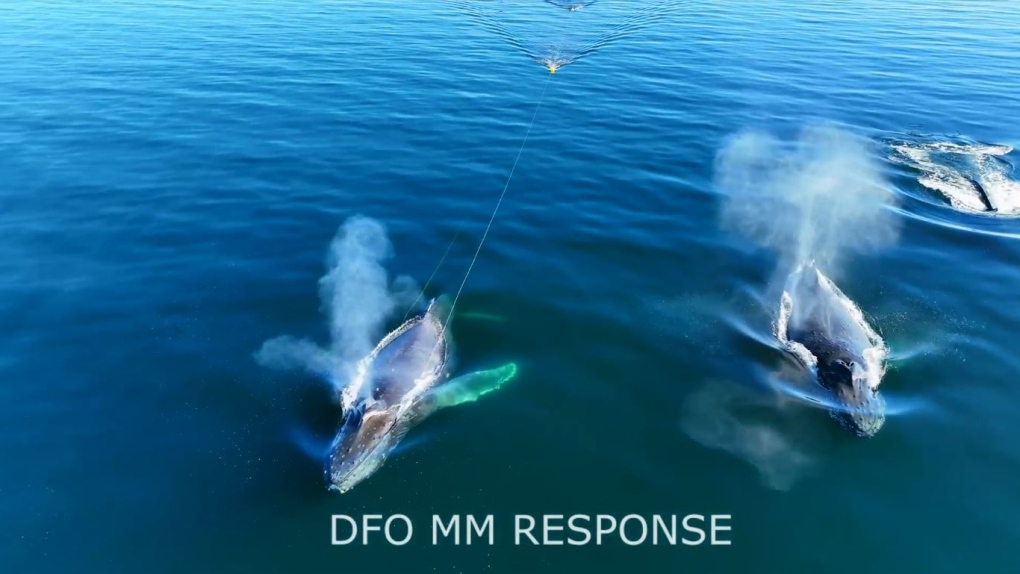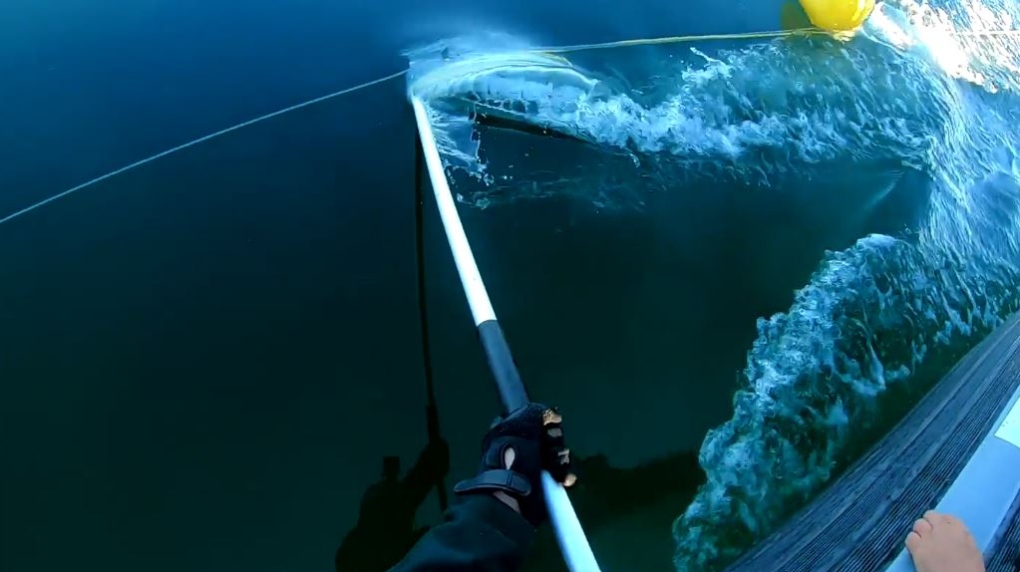Humpback whale freed from ropes in remarkable B.C. video
A humpback whale that was entangled in ropes and buoys has been rescued by members of the Department of Fisheries and Oceans marine mammal response team.
The rescue occurred on Friday in the northern section of the Strait of Georgia near Powell River, B.C.
DFO staff originally got a call about an entangled whale towing a yellow buoy on Thursday near Nanaimo, B.C., but were unable to find it at the time.
DFO Marine Mammal Response member Paul Cottrell says the team was returning home from Nanaimo after its initial search when they received another report of a whale dragging a yellow buoy, this time near Texada Island, B.C.
"We then got a call Friday morning. There was a whale watching group off Texada that saw a whale heading north tugging a buoy," he said.
The whale watching vessel was able to keep an eye on the location of the entangled whale until fisheries officers from Powell River arrived and equipped the animal with a satellite tag.
Cottrell's team then headed up to the scene from Vancouver and used a drone to help get a sense of what was affecting the humpback.
 An image from the rescue is shown. (DFO)
An image from the rescue is shown. (DFO)
Drone video shows that the distressed whale was being accompanied by two other humpbacks.
"It was a real complicated rescue because this animal had companion animals," said Cottrell.
"It was originally one animal and then it had three companion animals at one point, then for the majority of the rescue it had two animals with it," he said.
Cottrell says the team was concerned that the other whales would get wrapped up in the fishing gear that was trailing behind the entangled humpback.
"So it was a lot of patience and real great work from the team to take their time and get the gear off [safely,]" he said.
Cottrell said the humpback had 91 metres of polysteel rope stuck in its mouth and baleen, which could have affected its ability to eat – or even prove fatal if it was ingested.
The rope is believed to have been part of recreational prawning gear.
 An image from the rescue is shown. (DFO)
An image from the rescue is shown. (DFO)
Cottrell says humpback whales are getting ready to migrate to warmer waters, like off the coasts of Hawaii or Mexico, as winter approaches.
"So it's great that this whale won't have this gear on him when he makes that trip," he said.
Cottrell adds that it's always gratifying for the team to complete a rescue.
"We did with the drone get a parting shot of the animal and its two companion animals just zipping off – basically into the sunset – because it was late in the day," he said.
'GHOST GEAR'
Alys Hoyland, with the Tofino-based Ocean Legacy Foundation, says discarded fishing gear is a huge source of ocean pollution, and runs the risk of entangling whales and other sea life.
She says conservationists would like to see more accountability for fishing gear that breaks loose, is accidently dropped off boats, or is intentionally dumped into the ocean.
One step that the federal government could take to reduce wayward aquaculture gear is implementing a system that makes sure fishing operations come back with all of the gear they left with for the day, says Hoyland.
She adds that while it's important to reduce single-use plastics, about 80 per cent of ocean plastics comes from lost fishing gear, sometimes called "ghost gear."
"There's a disproportionate emphasis placed on single-use plastics and post-consumer waste," she said.
Cottrell says he agrees that ghost gear is an issue, but says organizations are working to invent safer equipment every day.
"Hopefully over time with these pilot projects and implementation of management measures we'll reduce the number of entanglements going forward," he said.
"It's not only a Canadian issue, it's an international issue," said Cottrell, adding that much of the gear they remove from animals actually comes from the U.S., and occasionally as far away as Asia.
CTVNews.ca Top Stories

'Mayday!': New details emerge after Boeing plane makes emergency landing at Mirabel airport
New details suggest that there were communication issues between the pilots of a charter flight and the control tower at Montreal's Mirabel airport when a Boeing 737 made an emergency landing on Wednesday.
Trudeau appears unwilling to expand proposed rebate, despite pressure to include seniors
Prime Minister Justin Trudeau does not appear willing to budge on his plan to send a $250 rebate to 'hardworking Canadians,' despite pressure from the opposition to give the money to seniors and people who are not able to work.
Hit man offered $100,000 to kill Montreal crime reporter covering his trial
Montreal news outlet La Presse says a hit man offered $100,000 to have one of its crime reporters assassinated.
Cucumbers sold in Ontario, other provinces recalled over possible salmonella contamination
A U.S. company is recalling cucumbers sold in Ontario and other Canadian provinces due to possible salmonella contamination.
Trudeau says no question incoming U.S. president Trump is serious on tariff threat
Prime Minister Justin Trudeau says incoming U.S. president Donald Trump's threats on tariffs should be taken seriously.
Insurgents breach Syria's second-largest city Aleppo in shock offensive
Insurgents breached Syria's second-largest city Aleppo after blowing up two car bombs on Friday and were clashing with government forces on the city's western edge, according to a Syria war monitor and fighters.
Here's how thick ice needs to be to park a truck on it, according to Sask. Water Security Agency
The Saskatchewan Water Security Agency (WSA) says ice should be at least one foot (30 centimetres) thick before it's safe to drive a car or light truck on a frozen body of water.
Democratic lawmakers from Connecticut report Thanksgiving bomb threats against their homes
At least six Democratic members of Congress from Connecticut were targeted by bomb threats on their homes Thursday, the lawmakers or their offices said.
Latest updates: Tracking RSV, influenza, COVID-19 in Canada
As the country heads into the worst time of year for respiratory infections, the Canadian respiratory virus surveillance report tracks how prevalent certain viruses are each week and how the trends are changing week to week.

































